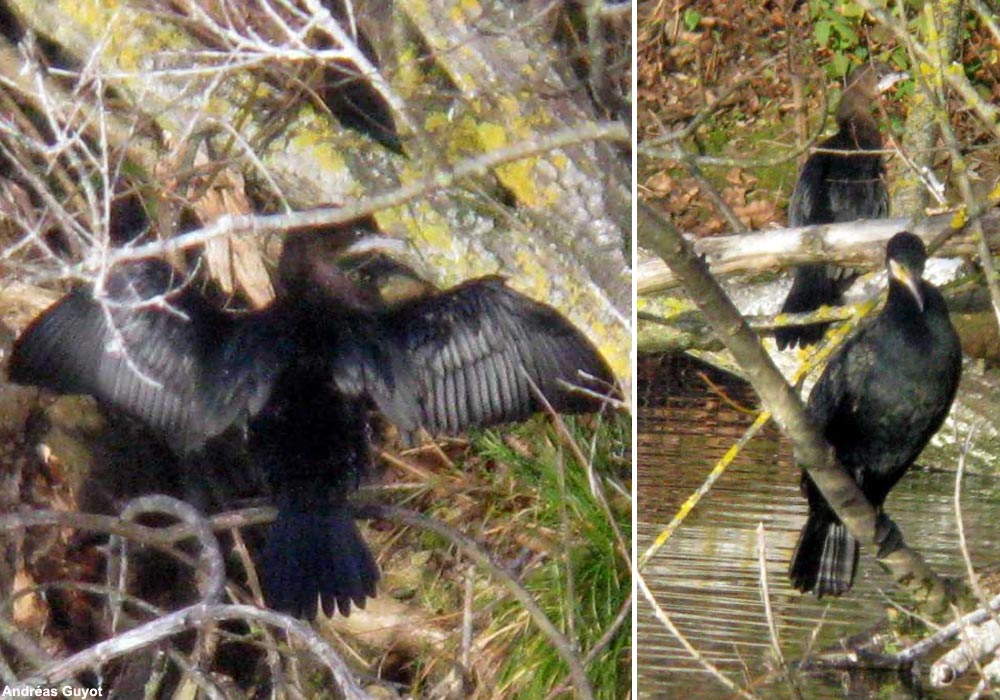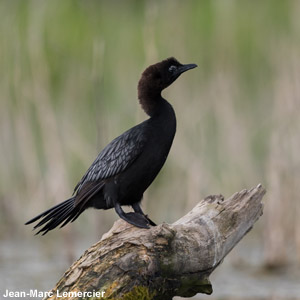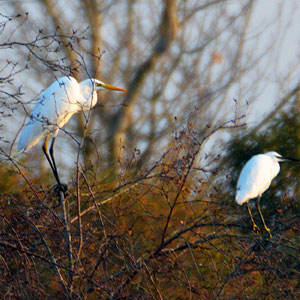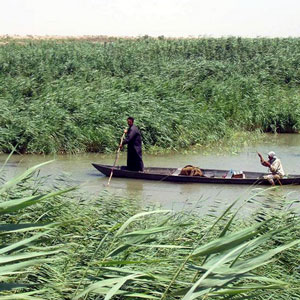Magazine | Analyses
Le Cormoran pygmée en France : vers une installation future ?

Cormoran pygmée (Microcarbo pygmaeus) dans une ancienne gravière près de Carbonne (Haute-Garonne) le 14 janvier 2020. À droite, notez la différence de taille avec un Grand Cormoran (Phalacrocoarx carbo).
Photographies : Andréas Guyot / Oiseaux des Pyrénées 64
Introduction
Le Cormoran pygmée (Microcarbo pygmaeus) est le plus petit cormoran nichant en Europe, avec une taille légèrement inférieure à celle d’un Canard colvert (Anas platyrhynchos). Son aire de répartition mondiale est limitée au sud-est du Paléarctique occidental, de l’Italie et de l’Autriche aux côtes de la mer Caspienne et à l’Irak. Sa population européenne, qui représente près de 80 % du total mondial, serait comprise entre 37 600 et 50 400 individus.
En France, depuis l’hiver 2011-2012, au moins 22 données ont été signalées, ce qui constitue une augmentation importante par rapport aux sept qui avaient acceptées par le Comité d’Homologation National entre 1981 et 2009. Cette accélération s’explique peut-être en partie par une pression d’observation accrue et par la mise en ligne d’outils de partage des informations, mais elle s’inscrit surtout dans le schéma général de la progression de l’espèce vers l’ouest de l’Europe, qui l’a conduit notamment à s’installer de façon pérenne en Italie et en Autriche.
Dans cet article, nous présentons des éléments qui suggèrent que son installation en France n’est sûrement qu’une question de temps. Nous remercions les photographes qui nous ont aidés à illustrer cet article.
Abstract
The Pygmy Cormorant (Microcarbo pygmaeus) is the smallest cormorant species in Europe, with a size slightly smaller than that of a Mallard (Anas platyrhynchos). Its global range is limited to the south-east of the Western Palearctic, from Italy and Austria to the coasts of the Caspian Sea and to Iraq. Its European population, which represents nearly 80% of the world total, is estimated to be between 37,600 and 50,400 individuals.
In France, since the winter 2011-2012, at least 22 data have been reported, which constitutes a significant increase compared to the seven which were accepted by the National Homologation Committee between 1981 and 2009. This acceleration can be explained partly through an increasi,g number of birders and by new on-line tools to sharing data, but it is above all coherent with the progression of the species towards Western Europe , which notably led him to settle permanently in Italy and Austria.
In this article, we present some elements which suggest that its installation in France is surely only a question of time. We thank the photographers who helped us illustrate this article.
Poursuivez la lecture de cet article, en vous abonnant dès maintenant !
Découvrez les Archives d’Ornithomedia.com
Pour seulement 10,00 €TTC/an (ou 6,00 € les 6 mois)
Profitez de plusieurs centaines d’articles en accès illimité et sans aucun engagement.
Compléments
Dans la rubrique Observations d’Ornithomedia.com
Cormoran pygmée (Microcarbo pygmeus)
Ouvrage recommandé
Le guide Ornitho de L. Svensson et al
Sources
- Paul Voskam, Stefano Volponi et Stef van Rijn (2005). Global population of the Pygmy Comorant Microcarbo pygmeus. Cormorant Research Group Bulletin. Wetlands International. www.nemoambiente.com
- Erwin Nemeth (2007). The Pygmy Cormorant (Microcarbo pygmeus) – a new breeding bird in Austria. Egretta. Volume: 49, Pages: 2-5. www.mendeley.com
- Marva Shmueli, Zeev Arad, Gadi Katzir, Ido IZHAKIb (2003). Israel Journal of Zoology. Volume: 49, Issue: 2, Pages: 159-173. www.mendeley.com
- Ahmand Barati, Safoura Javan, Mohammad E. Sehhatisabet (2008). Reproductive biology of Pygmy Comorant Microcarbo pygmeus in Siahkeshim protected area, Northern Iran. Marine Ornithology 36: 163–166. www.marineornithology.org
- Belik V. P. (2007). On expansion of the pygmy cormorant (Phalacrocorax pygmaeus, Pelecaniformes) in Southern Russia. Zoologiceskij žurna. Vol. 85, no7, pp. 859-864. http://cat.inist.fr/?aModele=afficheN&cpsidt=18328399
- Elena Kreuzberg-mukhina (2008). Distribution and Population Trends of Pygmy Cormorant Phalacrocorax pygmaeus in Central Asia , with Particular Reference to the Republic of Uzbekistan. Volume 3, numéro 1/2, pages: 53-66. www.mendeley.com
- Hemandez-Carrasquilla F., T. Tyrberg & A. von den Driesch (1999). A record of Pygmy Cormorant Microcarbo pygmaeus from Medieval Spain. Ardea 87(2): 285-288. http://www.avibirds.com/pdf/D/Dwergaalscholver1.pdf
- Limicola (2008). Seltene Vogelarten in Deutschland von 2001 to 2005. Numéro 22. www.limicola.de




 3 commentaires
3 commentaires



3 commentaire(s) sur ce sujet
Participer à la discussion !Andréas GUYOT
PAU
Posté le 17 janvier 2020
Je pose une question: comment faire pour que celui-ci ne subisse pas le même sort qu’a subi le grand cormoran ?
Ornithomedia
sevran
Posté le 17 janvier 2020
Bonjour, bonne question, il faudrait voir comme cela se passe en Italie, où quelques centaines de couples nichent depuis les années 1990. A priori, l’impact est très réduit.
Olivier Taylor
Bruxelles
Posté le 26 mars 2018
Il y en a un à Bruxelles depuis plus de deux mois, si vous voulez des photos, welcome.